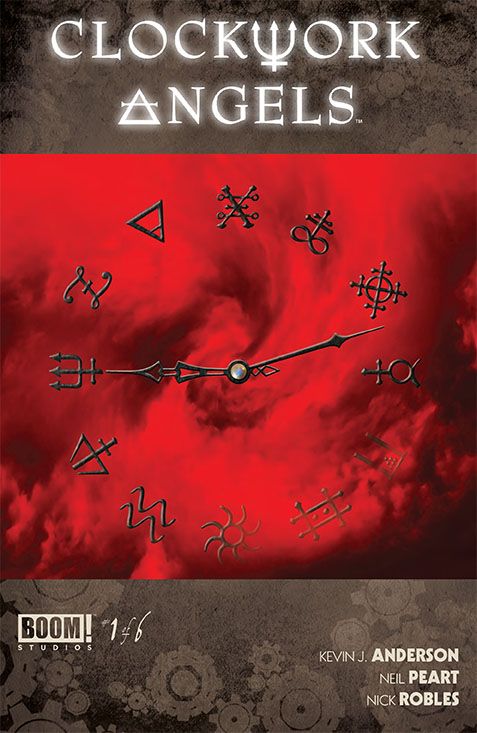Spinning out from the imaginative musical collaborations of the Canadian power-trio, Rush, "Clockwork Angels" #1, written by Kevin J. Anderson, with additional credit to Rush's drummer, Neil Peart, is a magnificent introduction to a world that's just familiar enough to be comfortable and just different enough to be interesting. Sharing a title with an album from Rush that also inspired a novel from Anderson, "Clockwork Angels" #1 opens a steampunk world for exploration.
"Everything has its place and every place its thing," is uttered more than once and by multiple people as the world of "Clockwork Angels" #1 ticks along. Anderson drops such philosophical nuggets throughout the issue and also brings in lyrics from the album through the dialog of the characters introduced. Only one character is truly given a full, proper introduction: point of view guide Owen Hardy. Owen hails from Barrel Arbor, and is an assistant apple orchard manager and a dreamer in a world filled with grounded feet and scheduled lives. The issue opens with an elder Owen reflecting back upon what led him to the place he inhabits on that first page. Anderson immediately endears Owen to the reader, not unlike George Lucas finding a way to sew Luke Skywalker into the hearts of viewers. Owen has a life to live and tasks to accomplish. He lacks for nothing, but wants to know more. In this sense, "Clockwork Angels" #1 treads familiar ground for stories seen time and again. Anderson moves beyond that, however, crafting the world around Owen to emphasize the differences rather than dwell upon similarities.
In a world where, "all is for the best," the Watchmaker rules over all, with scheduled rainstorms that run like trains and trains -- or the night steamer as Owen calls the dirigible-crossed locomotive -- that run like clockwork, everything has its time and place. Owen is betrothed to Lavinia, who barely tolerates her intended's dreaming. Throughout "Clockwork Angels" #1, reference is made to the Anarchist, a freedom extremist with a "disordered mind." That freedom causes much consternation among the people of Barrel Arbor. It's not an unfamiliar story, but it is an engaging one, in part due to its familiarity, but also to the care Anderson places in constructing the world.
Couched in magnificent design work from Emi Yonemura Brown, the gorgeous, painterly artwork from Nick Robles is custom fit for a steampunk tale. The colors are real and organic, but occasionally Robles sparks the imagery with iridescent glowing that seems equivalent with magic. Those instances are all electric blue, which virtually springs off the page in sharp contrast to the rest of the imagery present. That energy powers everything fantastic about the story within "Clockwork Angels" #1, including the night steamer. Robles pours just as much care and consideration into the artwork as Anderson has into the story, making this truly a collaborative effort. The artist brings enough realism to temper the world within these pages and makes everything seem believable. The elder version of Owen that opens this issue is so clearly the same young man the bulk of this comic book follows along. The world around Owen isn't flat or generic, but thoroughly imagined and brought to life with watercolor-like lushness in Robles' art.
While this is a BOOM! Studios project, it exhibits some sensibilities and attitude I tend to associate with its Archaia imprint, perhaps illuminating the osmosis present in the merger between publishers. You don't have to be a Rush fan to appreciate the gorgeous artwork and the engaging story present in "Clockwork Angels" #1, but it certainly brings a little more sizzle for readers whose imagination has a place for the worlds constructed through the music of Neil Peart and his bandmates, Geddy Lee and Alex Lifeson.

